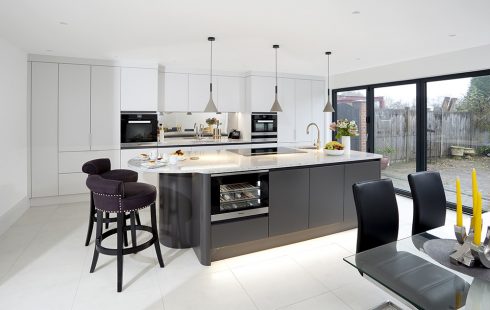
Stylish walk-in shower
Shower rooms and wet rooms are important. Why? Well because of the time we all spend in them. According to research by laterooms.com, reported in the
Daily Mirror, on average we shower on 227 days a year, bath on 4 and take 111 days without washing! Now, while these figures are a bit shocking, they do indicate the overwhelming preference for showering over bathing.
“The vast majority of women (71%) apparently take showers of 10 minutes or less and a quarter of women (26%) manage to take showers of five minutes or less. This is only slightly below the number of men who do so (75% and 30% respectively). There are also intriguing differences on age, with time spent in the shower decreasing with increasing age. The 55s and over (mean shower time: 8 mins, 41 seconds) are five minutes faster than people aged 18 to 24 (mean shower time: 13 mins 26 seconds) with well over a third (39%) of people aged 55 or over even managing to shower in five minutes or less”. (source
Guardian and Shower Power campaign 2014)
If we spend around 8 minutes in the shower for 222 days a year and live to about 80 years that’s about 100 days in a lifetime or over three months. That’s why you need to take showers seriously and, like beds, invest in a good one.
Whatever happened to the good old-fashioned shower?

Built in cubicle with rain head
In the old days, if you wanted a shower then you had one on your bath taps or went out and bought a shower cubicle; tray and sides. No one thought much beyond that. Things had often not progressed from attaching a rubber hose to the bath tap but many had a gleaming glass (or plastic) box with its own shower head fed directly off the mains.
Showers over the bath aren’t a bad thing. Despite being viewed as a poor alternative to stand-alone showers, over-the-bath showers are the only option for some bathrooms, especially those too small to take a separate enclosure. For these showers damp, unsightly curtains are giving way to modern glass and chrome dividers. The baths themselves are also adapting to containing showers by having flatter, non-slip, bottoms to make it easier and safer to shower.
The range of showers available today is wider than ever, but the fittings are such that people want to mix and match their particular preferences and many people come to professionals like us to get their bathroom designed around their tastes.
Here’s a quick checklist before buying a shower/wet room
- How powerful do I want my shower to be? – see ‘How to increase the power of your shower’ below
- Where are your pipes? – You can save money by staying close to existing water and waste pipes
- What does my family want? – Consider the height of your family members. Controls should be within easy reaching distance for everyone to use comfortably.
- Is it easy to clean? – see ‘What is a Wet Room’ below
- What style do I want? – see ‘Types of shower head’ below
- Do you want a head with different settings – such as rain, pulse/massage, jet, mist?
- How much do you want to spend? – always a decider but remember, you’re going to be in there for three months!

Traditional cubicle with rain head
What is also important as the design is the practical performance of the shower and by that we mean water pressure. It’s all very well to have a beautiful shower room but if the water comes trickling forth then you won’t enjoy the bracing joy of a jolly good shower.
How to increase the power of your shower: –
1. A quick solution to purchase a special low pressure shower head. It will work better than a standard shower head as it is designed to perform better in low water pressure situations
2. Install a pressurised cylinder – replace your cold water storage tank which feeds the hot water cylinder with a pressurised cylinder that takes its feed directly from the mains. Expensive but should last a lifetime
3. Fit a cold water accumulator – with an electric shower or ordinary shower this can generate a good pressure with no noise
4. Fit a booster pump or power shower – again, a good solution but can be noisy and is subject to certain rules regarding fitting. Best to use a professional plumber for this, 2 and 3.
Types of shower head

Wall mounted overhead shower
Wall mounted sideways shower head
This is the one used by most people. It is mounted on the wall and is adjustable as to which angle you prefer. Because it has to project water sideways it has to work that bit harder but popular none the less in a multitude of styles and adjustable. Some even come off the wall so you can spray those hard-to-reach areas. Most shower heads are adjustable as to spray width and strength.
Wall mounted overhead shower head
This is also fixed to the wall, but extends further out and over your head. This gives an opportunity for a larger rain style of head; simulating warm, tropical rainfall. The water simply has to fall. These shower heads are becoming very popular and usually have few adjustments as they are pretty thorough.

Wall mounted overhead rain shower
Ceiling mounted overhead shower head
The same as a wall-mounted overhead shower head but fixed to the ceiling. This is almost all about style – they can be suitable for wet rooms but it’s a matter of teste.
Jet or rain? A jet is more powerful towards a smaller target area.
A rain head is a gentler sensation of rainfall over a larger area.
Side mounted body massage jets
These are usually strong jets aimed at the body to add an invigorating massage effect to your regular shower. Although more complex to plumb in, and therefore more expensive, these appeal to those that worry about their cellulite and generally want to get even more from their shower.
What is a Wet Room?

Overhead rain head and detachable body shower head
More and more people are electing to have wet rooms as traditional shower rooms are seen as unnecessary. Modern materials mean that waterproofing a room is much easier to do so new houses and refurbishments frequently feature them instead of a bathroom with a shower cubicle.
Because that’s what a wet room is: – a modified shower room where, instead of a shower standing over a shower tray to drain the water, water is allowed to fall onto the floor of the room.
The water can do this because the room has a tiled floor that has been waterproofed (where tiles are laid onto a waterproof membrane). The whole room can be waterproofed in this way so there’s no need to have as many screens or any floor trays. The room’s floor has a gradient so that water drains into a drain and is taken away.
The advantages of a Wet Room
- Wet rooms have become popular because of the de-cluttering that it makes possible. You no longer need any of the bathroom elements that prevent water going where it’s not supposed to – because the whole room is waterproof.
- They don’t have to be installed downstairs. With today’s materials they can be anywhere in the house.
- Dividers, trays, sealant, mats, floor lips and internal walls can all be done away with so the open plan design can be airier and lighter.
- This is especially true for smaller rooms and en-suites which can be made to look larger, brighter and contemporary.
- With the wide variety of tiles and stone flooring you can get a surprisingly modern design for relatively low cost by opting for a wet room. You don’t have to buy a shower cubicle or a bath for a start.
- The lack of fittings also means a wet room is easier to clean.
- Yet another benefit of a clean, open plan design is that the room will last a lot longer than traditional shower rooms. It can be updated with soft fabrics and other bathroom accessories that keep it up-to-date.
- Furthermore, assuming it’s professionally fitted, you can rest assured that it’ll be properly waterproofed and that there won’t be any water damage to your house.
- Wet rooms are also very popular with the disabled, wheelchair users or the elderly who may not be able to climb into and out of a shower like they used to do!
A word of caution

Another shower with a detachable body shower head
Of course, good as this modern open-plan feel is, you will not have the benefit of isolating the shower area, with its steam and condensation, from other parts of the wet room so do bear this in mind. Towels, flannels, loo roll, lampshades and mats will become damp.
A wet room does have to be tiled from floor to ceiling so, a lot of tiles. It may well be necessary to employ a professional tiler with the added expense that will bring. In addition if the only bathroom in the house is a wet room, it may reduce your chances of selling at the right price.
And they’re not slippery, although a wet, tiled floor may seem daunting and dangerous, with non-slip tiles correctly fitted, a wet room can provide a completely safe shower area. Without having to step in and out of a bath or shower, the risk of tripping is also decreased.
Other developments in Shower Rooms
Steam Showers – A steam shower looks like a normal shower, although it may be larger. It’s designed to handle steam (heated water vapour) from a humidifying steam generator. They can be larger as a steam shower can be a social event for more than one person. They are usually instead of rather than as well as a conventional shower and therefore have many additional features including a regular shower.
Sun showers – As the name suggests these are booths where you can get a sun tan while having a shower. They use carefully measured amounts of UV light to tan your skin and argue that you get a nicer complexion by regularly taking a well-balanced sunbath. Manufacturers argue that it’s healthier and less stressful to one’s skin to tan in this way.
Home Spas, hot tubs and more – we begin to digress here but as technology advances and our requirements become more exotic then designers are creating new ways to enjoy water and the bathing process.


